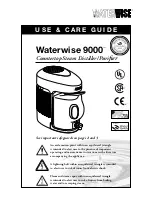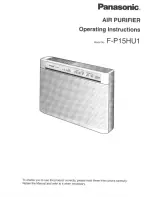
Electrical Maintenance
73
Interface Board Fuse F4
The interface board has a 300 ohm resistor and a
resistor bypass fuse (F4) in the alternator
excitation circuit. The fuse and resistor are
connected in parallel and are located on the
interface board. Removing the resistor bypass
fuse places the 300 ohm resistor in the excitation
circuit as required for Thermo King alternators
(and Australian Bosch alternators). Installing the
resistor bypass fuse removes the 300 ohm resistor
from the excitation circuit as required for
Prestolite alternators. See the specific unit wiring
diagram for exact details.
NOTE: The F4 fuse must be removed from the
interface board on units equipped with Thermo
King alternators. The voltage regulator on the
Thermo King alternators will be damaged if the
unit is turned On with the F4 fuse in place on
the interface board.
Test Equipment for Checking
Voltage and Current
Always use accurate test equipment such as the
Fluke 23 Digital Multi-Meter and the Fluke
Clamp-On Ammeter accessory when checking
alternator circuit voltage and amperage. See the
table below for Thermo King service parts
numbers. Be sure voltages are measured from the
designated terminal to the alternator chassis
ground. All voltages are DC voltages unless
otherwise noted.
Alternator Load Test
Thermo King no longer recommends a full field
test for determining the alternator current output.
Full fielding an alternator can cause increases in
alternator output voltage that may damage internal
alternator or unit components. This damage may
not be readily apparent.
To test the alternator under load, Thermo King
recommends the use of a clamp-on ammeter to
monitor output current, both on initial startup and
under full unit load conditions. For example, on
multi-temp units, all remote evaporators should be
turned on.
General Diagnostic and Warranty
Evaluation Procedure
Complete the following diagnostic procedures
before replacing an alternator or the voltage
regulator.
1. When testing an alternator, use accurate
equipment such as a Thermo King P/N
204-1079 digital multimeter and a Thermo
King P/N 204-947 amp clamp or an
equivalent.
2. Make sure the drive belts and pulleys of the
charging system are in good condition and are
adjusted properly before testing the alternator.
Be sure the pulleys are the correct size. Worn
belts, loose belts and worn or improperly sized
pulleys will lower the output of the alternator.
3. The battery must be charged and in good
condition, the battery cable connections must
be clean and tight, and the 2A, SENSE
(sense), and EXC (excitation) circuits must be
connected properly. All charging circuit
connections must be clean and secure. If the
unit battery is questionable, a known good
jumper battery should be substituted for
alternator testing.
NOTE: If the unit battery is questionable, a
known good jumper battery should be
substituted for alternator testing.
NOTE: Do not perform this test with a
battery charger connected to the unit battery.
NOTE: All voltage readings should be taken
between the chassis ground on the alternator
and the terminals indicated, unless stated
otherwise.
4. Check that the resistor bypass fuse (F4) has
been removed. Units with Thermo King
alternators must have the resistor bypass fuse
(F4) removed.
Meter
Service
Part
Number
Fluke 23 Digital Multi-Meter
204-1079
Clamp-On Ammeter for above Meter
204-947
Summary of Contents for T-1080S
Page 102: ...Engine Maintenance 101 Figure 182 Fuel and Oil System Components ...
Page 182: ...Index 181 Unit Options 23 W wiring 79 wiring diagrams index 182 ...
Page 184: ...183 Schematic Diagram Page 1 of 2 RELEASED 06 Jul 2015 13 52 47 GMT 7 ...
Page 185: ...184 Schematic Diagram Page 2 of 2 RELEASED 06 Jul 2015 13 52 47 GMT 7 ...
Page 186: ...185 Wiring Diagram Page 1 of 5 ...
Page 187: ...186 Wiring Diagram Page 2 of 5 RELEASED 06 Jul 2015 13 52 47 GMT ...
Page 188: ...187 Wiring Diagram Page 3 of 5 ...
Page 189: ...188 Wiring Diagram Page 4 of 5 RELEASED 06 Jul 2015 13 52 47 GMT ...
Page 190: ...189 Wiring Diagram Page 5 of 5 ...
















































